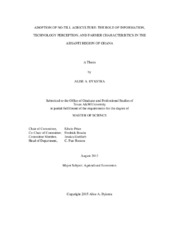| dc.description.abstract | In recent years, there has been growing concern about soil productivity and environmental implications of conventional agriculture, especially tillage practices. This has led to the promotion of conservation agriculture and more specifically, no-till agriculture. No-till improves the physical and chemical characteristics of the soil, allows land to stay in production for an extended period of time, improves moisture conservation, and is labor saving. This paper uses three theories to discuss factors that influence farmers’ decision to adopt or not adopt no-till farming technology. The three theories use different assumptions and hypotheses about technology. The three theories are: 1) economic constraints, distribution of resources; 2) technology characteristics, perceived attributes of the technology; and 3) innovation diffusion, access to information.
The data for the study was collected from farmers in the Ashanti region. A binary probit model is used to empirically test the adoption hypotheses. Four models were estimated to test the three theories, a model for each respective theory and a model that combined all three theories. Three farmer characteristic variables, gender, experience, and education, are included in all four models. Gender and experience are significant in the technology characteristics and combined models. The significant variables for the economic constraint model are labor, tenure, and income. The technology characteristic model has only one variable, the popularity of the technology, to be significant. In-person contact with extension agents and farmers as well as attendance at the no-till training Center are the significant innovation diffusion variables. Once all three models are combined labor, total land, perception of a problem, in person contact with farmers and extension agents, and attendance at the Center are significant.
The data showed variables from all three theories are significant in the farmer’s decision. Looking at only one theory can lead to a skewed picture and over emphasis on one area, leading to ineffective policies and projects with poor adoption rates. All three theories should be considered to create policies and projects to increase adoption rates of no-till.
The data for the study was collected from farmers in the Ashanti region. A binary probit model is used to empirically test the adoption hypotheses. Four models were estimated to test the three theories, a model for each respective theory and a model that combined all three theories. Three farmer characteristic variables, gender, experience, and education, are included in all four models. Gender and experience are significant in the technology characteristics and combined models. The significant variables for the economic constraint model are labor, tenure, and income. The technology characteristic model has only one variable, the popularity of the technology, to be significant. In-person contact with extension agents and farmers as well as attendance at the no-till training Center are the significant innovation diffusion variables. Once all three models are combined labor, total land, perception of a problem, in person contact with farmers and extension agents, and attendance at the Center are significant.
The data showed variables from all three theories are significant in the farmer’s decision. Looking at only one theory can lead to a skewed picture and over emphasis on one area, leading to ineffective policies and projects with poor adoption rates. All three theories should be considered to create policies and projects to increase adoption rates of no-till. | en |


